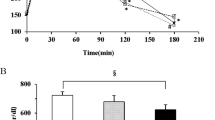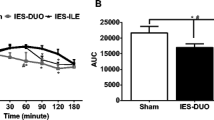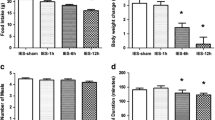Abstract
Introduction
Intestinal electrical stimulation (IES) has been reported to reduce body weight and improve glucose tolerance in obese and diabetic rats. Our study aimed to investigate possible IES mechanisms involving incretin hormones using intraduodenal glucose infusion in rats. We hypothesized that the enhanced release of postprandial glucagon-like peptide-1 (GLP-1) at early phase by IES was mediated through neuro/paracrine mechanisms involving the vagal nerve and glucose-dependent insulinotropic peptide (GIP).
Methods
Fifteen normal male Sprague-Dawley rats chronically implanted with duodenal electrodes for IES, and an intra-duodenum catheter for the infusion of glucose were studied in a series of sessions with IES of different parameters with and without atropine and M3 receptor antagonist. Blood samples were collected via the tail vein for the measurement of blood glucose, and plasma GLP-1, and GIP.
Results
(1) Compared to sham-IES, IES of 0.3 ms reduced blood glucose by 16.5–28.4% between 30 and 120 min (all time points p < 0.05), and IES of 3-ms reduced blood glucose at 60 (12.6%) and 90 min (11.8%). IES of 0.3 ms showed a greater hypoglycemic effect than 3 ms (p = 0.024) at 30 min. (2) IES elevated plasma GLP-1 with 0.3 ms (p = 0.001) and with 3 ms p = 0.03). (3) IES substantially elevated plasma GIP with 0.3 ms (p = 0.002) and with 3 ms (p < 0.001). (4) Pretreatment of atropine and the M3 receptor antagonist 4-DAMP blocked the effects of IES on GLP-1, GIP, and blood glucose.
Conclusions
IES reduces postprandial blood glucose by enhancing the release of GLP-1 and GIP mediated via the cholinergic mechanism.








Similar content being viewed by others
References
Chen L, Magliano DJ, Zimmet PZ. The worldwide epidemiology of type 2 diabetes mellitus--present and future perspectives. Nat Rev Endocrinol. 2011;8(4):228–36.
Kahn BB, Flier JS. Obesity and insulin resistance. J Clin Invest. 2000;106(4):473–81.
Tasyurek HM, Altunbas HA, Balci MK, et al. Incretins: their physiology and application in the treatment of diabetes mellitus. Diabetes Metab Res Rev. 2014;30(5):354–71.
Nauck M. Incretin therapies: highlighting common features and differences in the modes of action of glucagon-like peptide-1 receptor agonists and dipeptidyl peptidase-4 inhibitors. Diabetes Obes Metab. 2016r;18(3):203–16.
Maleckas A, Venclauskas L, Wallenius V, et al. Surgery in the treatment of type 2 diabetes mellitus. Scand J Surg. 2015;104(1):40–7.
De Luca M, Angrisani L, Himpens J, et al. Indications for surgery for obesity and weight-related diseases: position statements from the International Federation for the Surgery of obesity and metabolic disorders (IFSO). Obes Surg. 2016;26(8):1659–96.
Thaler JP, Cummings DE. Minireview: hormonal and metabolic mechanisms of diabetes remission after gastrointestinal surgery. Endocrinology. 2009;150(6):2518–25.
Wickremesekera K, Miller G, Naotunne TD, et al. Loss of insulin resistance after Roux-en-Y gastric bypass surgery: a time course study. Obes Surg. 2005;15(4):474–81.
Vetter ML, Cardillo S, Rickels MR, et al. Narrative review: effect of bariatric surgery on type 2 diabetes mellitus. Ann Intern Med. 2009;150(2):94–103.
Korner J, Bessler M, Cirilo LJ, et al. Effects of Roux-en-Y gastric bypass surgery on fasting and postprandial concentrations of plasma ghrelin, peptide YY, and insulin. J Clin Endocrinol Metab. 2005;90(1):359–65.
Sagar PM. Surgical treatment of morbid obesity. Br J Surg. 1995;82(6):732–9.
Crookes PF. Surgical treatment of morbid obesity. Annu Rev Med. 2006;57:243–64.
Sun Y, Chen J. Intestinal electric stimulation decreases fat absorption in rats: therapeutic potential for obesity. Obes Res. 2004;12(8):1235–42.
Aberle J, Busch P, Veigel J, Duprée A, Roesch T, Zu Eulenburg C, et al. Duodenal electric stimulation: results of a first-in-man study. Obes Surg 2016;26(2):369–375.
Yin J, Zhang J, Chen JDZ. Inhibitory effects of intestinal electrical stimulation on food intake, weight loss and gastric emptying in rats. Am J Phys Regul Integr Comp Phys. 2007;293(1):R78–82.
Li S, Chen JDZ. Pulse width-dependent effects of intestinal electrical stimulation for obesity: role of gastrointestinal motility and hormones. Obes Surg. 2017;27(1):70–7.
Gautam D, Gavrilova O, Jeon J, et al. Beneficial metabolic effects of M3 muscarinic acetylcholine receptor deficiency. Cell Metab. 2006;4(5):363–75.
Chen JDZ, Yin J, Wei W. Electrical therapies for gastrointestinal motility disorders. Expert Rev Gastroenterol Hepatol. 2017;11(5):407–18.
Li S, Chen JDZ. Cellular effects of gastric electrical stimulation on antral smooth muscle cells in rats. Am J Phys Regul Integr Comp Phys. 2010;298(6):R1580–7.
Li S, Zhu W, Zhang S, et al. Chronic intestinal electrical stimulation improves glucose intolerance and insulin resistance in diet-induced obesity rats. Obes Silver Spring Md. 2017;25(6):1061–8.
Liu J, Xiang Y, Qiao X, et al. Hypoglycemic effects of intraluminal intestinal electrical stimulation in healthy volunteers. Obes Surg. 2011;21(2):224–30.
Ouyang X, Li S, Tan Y, et al. Intestinal electrical stimulation attenuates hyperglycemia and prevents loss of pancreatic β cells in type 2 diabetic Goto-Kakizaki rats. Nutr Diabetes. 2019;9(1):4.
Tolhurst G, Reimann F, Gribble FM. Nutritional regulation of glucagon-like peptide-1 secretion. J Physiol. 2009;587(Pt 1):27–32.
Anini Y, Fu-Cheng X, Cuber JC, et al. Comparison of the postprandial release of peptide YY and proglucagon-derived peptides in the rat. Pflugers Arch. 1999;438(3):299–306.
Gutzwiller JP, Göke B, Drewe J, et al. Glucagon-like peptide-1: a potent regulator of food intake in humans. Gut. 1999;44(1):81–6.
Baggio LL, Drucker DJ. Biology of incretins: GLP-1 and GIP. Gastroenterology. 2007;132(6):2131–57.
Rask E, Olsson T, Söderberg S, et al. Impaired incretin response after a mixed meal is associated with insulin resistance in nondiabetic men. Diabetes Care. 2001;24(9):1640–5.
Sandoval D, Dunki-Jacobs A, Sorrell J, et al. Impact of intestinal electrical stimulation on nutrient-induced GLP-1 secretion in vivo. Neurogastroenterol Motil. 2013;25(8):700–5.
Theodorakis MJ, Carlson O, Michopoulos S, et al. Human duodenal enteroendocrine cells: source of both incretin peptides, GLP-1 and GIP. Am J Physiol Endocrinol Metab. 2006;290(3):E550–9.
Rocca AS, Brubaker PL. Role of the vagus nerve in mediating proximal nutrient-induced glucagon-like peptide-1 secretion. Endocrinology. 1999;140(4):1687–94.
Christensen MB. Glucose-dependent insulinotropic polypeptide: effects on insulin and glucagon secretion in humans. Dan Med J. 2016;63(4)
Parker HE, Habib AM, Rogers GJ, et al. Nutrient-dependent secretion of glucose-dependent insulinotropic polypeptide from primary murine K cells. Diabetologia. 2009;52(2):289–98.
Anini Y, Brubaker PL. Muscarinic receptors control glucagon-like peptide 1 secretion by human endocrine L cells. Endocrinology. 2003;144(7):3244–50.
Cellini J, Jukic AMZ, LePard KJ. Neostigmine-induced contraction and nitric oxide-induced relaxation of isolated ileum from STZ diabetic guinea pigs. Auton Neurosci Basic Clin. 2011;165(2):178–90.
Anini Y, Hansotia T, Brubaker PL. Muscarinic receptors control postprandial release of glucagon-like peptide-1: in vivo and in vitro studies in rats. Endocrinology. 2002;143(6):2420–6.
Xu X, Lei Y, Chen JDZ. Duodenum electrical stimulation delays gastric emptying, reduces food intake and accelerates small bowel transit in pigs. Obes Silver Spring Md. 2011;19(2):442–8.
Wang WF, Yin JY, De Dz Chen J. Acceleration of small bowel transit in a canine hypermotility model with intestinal electrical stimulation. J Dig Dis. 2015;16(3):135–42.
Gautam D, Han S-J, Hamdan FF, et al. A critical role for beta cell M3 muscarinic acetylcholine receptors in regulating insulin release and blood glucose homeostasis in vivo. Cell Metab. 2006;3(6):449–61.
Ito Y, Kaji M, Sakamoto E, et al. The beneficial effects of a muscarinic agonist on pancreatic β-cells. Sci Rep. 2019;9(1):16180.
Abello J, Ye F, Bosshard A, et al. Stimulation of glucagon-like peptide-1 secretion by muscarinic agonist in a murine intestinal endocrine cell line. Endocrinology. 1994;134(5):2011–7.
Zhang J, Zhu H, Chen JDZ. Central neuronal mechanisms of intestinal electrical stimulation: effects on duodenum distention-responsive (DD-R) neurons in the VMH of rats. Neurosci Lett. 2009;457(1):27–31.
Sun Y, Qin C, Foreman RD, et al. Intestinal electric stimulation modulates neuronal activity in the nucleus of the solitary tract in rats. Neurosci Lett. 2005;385(1):64–9.
Funding
This study is supported by a grant from NIH: R01DK107754.
Author information
Authors and Affiliations
Corresponding author
Ethics declarations
Conflict of Interest
The authors declare that they have no conflict of interest.
Ethical Statement
All procedures performed in studies involving animals were in accordance with the ethical standards of the institutional and/or national research committee. This article does not contain any studies with human performed by any of the authors.
Additional information
Publisher’s Note
Springer Nature remains neutral with regard to jurisdictional claims in published maps and institutional affiliations.
Ms# OBSU-D-20-01260
Rights and permissions
About this article
Cite this article
Dong, Y., Zhang, Y., Li, S. et al. Intestinal Electrical Stimulation Enhances Release of Postprandial Incretin Hormones Via Cholinergic Mechanisms. OBES SURG 31, 1957–1966 (2021). https://doi.org/10.1007/s11695-021-05228-w
Received:
Revised:
Accepted:
Published:
Issue Date:
DOI: https://doi.org/10.1007/s11695-021-05228-w




